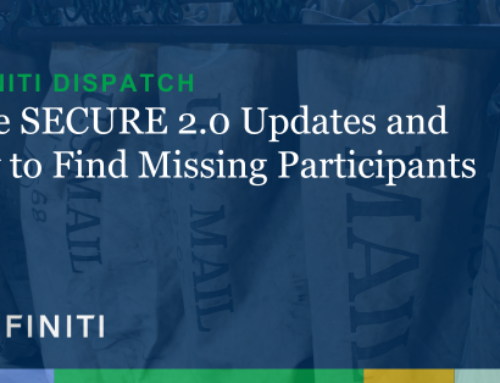If you don’t enroll employees when your plan document says you should — you could be breaking IRS rules, as well as mandates from the Department of Labor.
Keeping track of employee eligibility may be one of the most important jobs of a retirement plan sponsor. If you don’t enroll people in the retirement plan when your plan document says you should, you could be breaking Internal Revenue Service’s rules for ERISA-qualified plans1, as well as mandates from the Treasury Department and Department of Labor.
A great way to stay on top of who is eligible is to keep your plan’s census data accurate, as it helps you determine eligibility. (We covered the importance of high-quality data in “Retirement Plan Census Data – It’s Foundational and Fundamental” on definiti.com.) Incorrect or missing census data makes critical tasks impossible, such as knowing when employees are eligible for the retirement plan.
Eligibility Minimums from the IRS
While the IRS’s guidelines on eligibility are succinct, your plan document’s eligibility section could span three or four pages, just describing who is (or isn’t) eligible to enroll in the retirement plan.
Per the IRS2:
In general, an employee must be allowed to participate in a qualified retirement plan if they meet both of the following requirements:
- Has reached age 21
- Has at least one year of service
A plan cannot exclude an employee because he or she has reached a specified age.
As an employer, you can establish eligibility rules that are more generous than the IRS.’ For example, you could allow new employees to enter the 401(k) plan immediately. Or your brand-new retirement plan could waive eligibility requirements for everyone in your company employed on the plan’s effective date.
These eligibility conditions will be spelled out in your plan document and guide what you adhere to, no matter what. This means you can’t easily make an exception for “Jim,” a newly hired executive, who requests immediate eligibility because he contributed to his former company’s 401(k) plan.
Whenever you communicate information about eligibility to your workforce, whether in an employee handbook or on your intranet, the language should mirror what’s in the plan document.
And Speaking of the Plan Document …
If you know your plan document inside and out, you likely have the eligibility section memorized. This document, by the way, is the foundation of a qualified retirement plan. It describes the terms and conditions for employee participation and contributions to and distributions from the plan, among other things.
If your retirement plan ever gets audited by the IRS, it will check to make sure your eligible employees actually became enrolled in the plan based on how you describe eligibility in the plan document.
Safeguarding enrollment materials, making sure you have forms on file (either electronically or via a paper form), is your best line of defense against a potential audit. These materials prove that every person eligible for the plan is enrolled, even if they elected not to participate and chose a deferral rate of 0%.
Eligible Employees and Excluded Groups
Anyone who receives a W-2 from your company is an employee. (1099-form independent contractors are excluded from being eligible to enroll in the plan.) Eligible employees are factored into annual compliance testing, which allows you (or your third-party administrator) to generate accurate compliance testing results. As you may know, testing ensures the plan benefits your entire employee population, not just company owners or highly paid staff. Failing to meet the IRS’ “fairness” standards can mean fines, penalties and more.
In the plan document, you can exclude different groups of people, such as union employees, nonresident aliens and leased employees. If your plan excludes any of these groups, the IRS gives you a “free pass” from having to include these groups in compliance testing.
The plan document can also exclude groups of people that don’t get that free pass. You could exclude hourly workers, commissioned employees and people who work in a specific location or division. And while you’re allowed to do this, you must also test the retirement plan to make sure you fairly cover everyone — and this is something that needs a review each year.
Here’s an excluded group example: If you start a new division in an office that only has a few employees working there initially, it may be acceptable to exclude that group of people from the retirement plan. But if that location grows and more people work there, it’s possible your right to exclude them may go away. (Monitoring this is something a retirement services provider, like Definiti, can help you with each year.)
Two Methods for Crediting Service
Federal law sets the limits on eligibility, including the employee must be 21 to enroll in the plan, as we mentioned earlier. (Your retirement plan, however, could allow people aged 18 to participate.) You can also require up to one year of service before an employee can contribute to the retirement plan.
You have two options for crediting employee service to determine eligibility for enrolling in your retirement plan:
- The elapsed time method is the simplest to calculate because it’s based on the duration of employment versus hours worked.
- The other method, counting an employee’s hours worked from the date of hire, specifies a number of hours they must attain — but the period of time involved can’t exceed 12 months or require more than 1,000 hours in the counting period.
Everything is Fixable
Eligibility errors will occur across the life of a retirement plan, no matter how careful you are. You might enroll an employee earlier than they should be allowed because there’s a typographical error in the person’s date of hire or there is another type of tracking error.
There is more than one way to address an error like this. A correction you, as the plan sponsor, could make is to amend the retirement plan to allow that person to enroll earlier. And while you might like this option, you can’t do it in every situation. For example, if you accidentally brought the company owner’s son into the plan too early, you may not be able to correct by a plan amendment.
But what happens if you bring an employee in too late to the retirement plan? Most often, you will need to make up for the money the employee couldn’t contribute. And if your plan offers a matching contribution, you will need to make up for that money, as well.
As you can guess, this can be an expensive error, especially if it happens more than once, occurred years back or must be done for a group of employees. Staying on top of the enrollment process and acting quickly to fix errors is a critical task for certain.
We’re Here to Help
Determining eligibility and managing those rules and conditions ongoing is just one of a plan sponsor’s many administrative responsibilities. Laws and regulations for retirement plans frequently change, which may complicate your efforts to keep the plan compliant. Case in point: Effective for plan years beginning after December 31, 2020, Congress amended 401(k) rules so that certain long-term part-time employees must be allowed to make elective deferrals. (Refer to our ERISA Connection article “Including Long-Term Part-Time Employees in 401(k) Plans” on definiti.com.)
Partnering with a third-party administrator (TPA) is one way that more and more companies are managing their retirement plan benefits. In fact, 79% of employers choose a TPA instead of relying solely on in-house resources.3
If you’re ready to continue the conversation about eligibility or want to explore what’s involved in outsourcing administrative work to a TPA, call Definiti at 1-888-912-3653 or email sales@definiti-llc.com.
—
1. The Employee Retirement Income Security Act of 1974 established the rules for U.S. retirement plans.
2. Find the IRS’ eligibility requirements here: irs.gov/retirement-plans/plan-sponsor/401k-plan-qualification-requirements
3. The TPA statistic is from the Society of Professional Benefits Administrators.
This material has been prepared for informational purposes only, and is not intended to provide legal, tax or investment advice. Any tax-related discussion contained in this material is not intended or written to be used, and cannot be used, for (i) avoiding any tax penalties, or (ii) promoting, marketing or recommending to any other party any transaction or matter addressed herein. This material does not provide fiduciary recommendations concerning investments or investment management; it is not individualized to the needs of any specific benefit plan or retirement investor, nor is it directed to any recipient in connection with a specific investment or investment management decision. Please consult your independent legal counsel and/or professional tax advisor regarding any legal or tax issues raised in this material.
This information is intended to provide general information on matters of interest in the area of qualified retirement plans and is distributed with the understanding that the publisher and distributor are not rendering legal, tax or other professional advice. Readers should not act or rely on any information in this article without first seeking the advice of an independent tax advisor such as an attorney or CPA.





